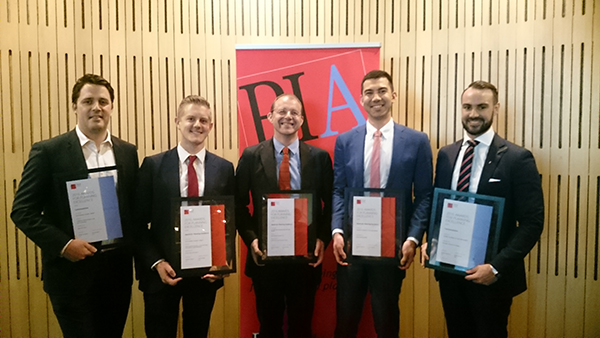
From left: Dean Hosking, Brendan Hoskins, Discipline Director, Simon Pinnegar, Richard Barry and Ryan Macindoe.
The PIA NSW awards aim to “showcase to our state, the community and industry the role of planners in planning for growth, creating great communities and places to live and work. The PIA awards demonstrate the various multidisciplinary tasks and value planners add in projects or policies.”
A panel of six judges made their selection from a field of 36 nominations this year, the largest number of nominations to date. Out of those 36 nominations four students and two researchers from UNSW Built Environment were awarded or commended in three categories.
They are:
- Young Planner of the Year: Dean Hosking
- Commendation: Brendan Hoskins
- Outstanding student project: Richard Barry
- Commendation: Ryan Macindoe
- Cutting edge research and teaching: City Futures Research Centre
- Commendation: Robert Freestone and Edgar Liu
Both Dean Hosking and Brendan Hoskins are alumnus of our Bachelor of Planning (now City Planning). Richard Barry and Ryan Macindoe graduated this year from the same degree, Robert Freestone is the Associate Dean of Research at UNSW Built Environment while Edgar Liu is a Research Fellow.
What the PIA had to say about them:
DEAN HOSKING
This Award recognises the outstanding contribution or achievement by a Young Planner.
The judges all agreed that this year’s young planner is highly motivated, makes a significant contribution to the planning profession, through his commitment and dedication to young planners.
He continually seeks to provide opportunities for young planners to expand their knowledge and expertise, as evident by his creation and development of the ‘Emerge Series’ and participation with the YP Connect conference stream.
He is an excellent role model for young planners, through his commitment to the planning profession, his advocacy for the role of planners within our communities and through the mentoring of other young planners as they complete their university studies and commence their planning careers.
BRENDAN HOSKINS
This young planner started work in his student year in 2011. He has been instrumental in expanding and enhancing his company’s capability and brought a new level of interest and innovation to the management of design competitions within his workplace.
Outside his work as a planning consultant, he was involved with a working group on the review of
the undergraduate and postgraduate planning programs at UNSW. The outcome of the review was an entire overhaul of the planning programs, both of which have been accredited by PIA and are now in place. The judges agreed that Brendan has made a good contribution to the planning professional over the past year.
RICHARD BARRY
Project: Exploring the virtual city - immersive public participation using VR headsets
This Award recognises outstanding planning work by a tertiary student and is made for a substantial project, report, book, theses, article or a piece of research which makes a significant contribution to issues relating to rural, regional and/or urban planning
For decades, Virtual Reality (VR) headsets providing a gateway into immersive digital representations of our environment have typically been the dreams of video gamers and sci-fi fans.
As part of this innovative movement, this student thesis explored a new participation technique for planners to utilise VR headsets to visualise future development during the public participation process by being immersed in a one- to-one scale digital model of their city or neighbourhood. The main research question answered was: “To what extent can VR headsets be used to better visualise proposed developments?”
The judges all agreed that this thesis took on a very cutting-edge topic and were particularly impressed by the practical research methods carried out. This method is now being used in development projects.
RYAN MACINDOE
Project: indigenous representation in the built environment
This student’s thesis explored ways in which Indigenous culture can be represented in the built environment and the importance of including Indigeneity within the planning process. The judges agreed that this thoughtful thesis offers an important contribution to a much- neglected aspect of urban Australia.
The thesis provides an important resource to shift built environment practitioners thinking and practices so that Indigeneity is embedded in planning and place making processes.
CITY FUTURES RESEARCH CENTRE
Project: Renewing the compact city: economically viable and socially sustainable approaches to urban redevelopment in a complex multi-stakeholder environment.
Strong population growth in Australian cities, particularly Sydney, mean the city needs to densify. This poses design, behavioral and regulatory challenge. An important regulatory change is dealing with older strata schemes that often sit on land under pressure for more intensive uses. They are also often at a point in their life-cycle when substantial investment to upgrade and ageing amenity or demolition is on the cards. This is ground-breaking research on the economic feasibility and social impact of strata renewal that has been incorporated in to the NSW Strata Schemes Development Act (2015.)
ROBERT FREESTONE AND EDGAR LIU
Project: Place and placelessness revisited.
The commendation is for an outstanding piece of work that revisits Ted Relph’s 1976 book, Place and Placelessness. The work draws on Australian, British, Japanese and North and South American evidence to bring our understanding of place in urban design and urban planning into the 21st century. An important theme is that the mobility of contemporary life mean that place and placelessness are no longer the opposites they were once understood to be.
You can read about all the PIA winners here.
